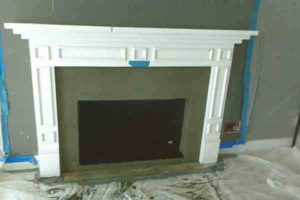 As professional chimney sweeps, there’s a common issue that we’ve been running into more and more during the past few years.
As professional chimney sweeps, there’s a common issue that we’ve been running into more and more during the past few years.
Contractors, interior designers, and do-it-yourself homeowners are removing the fireplace lintel. Perhaps this is to create, in their minds, a more aesthetically-pleasing fireplace by making a taller firebox opening. However, removing the lintel can create some major issues for the fireplace.
Many times, the removal of the lintel isn’t discovered until the homeowner calls a trained chimney professional to do a chimney sweeping or when a home inspector discovers it in the middle of escrow during a home inspection.
What Is A Fireplace Lintel?

The fireplace lintel is typically a metal L-shaped bar or a flat steel beam that supports the bricks and masonry above the firebox opening. The lintel runs the full width of the firebox opening and, by code, extends into each side by at least four inches. The purpose of the lintel is to support the masonry above the fireplace opening.
According to California Residential Code R1001.7 – Lintel and throat: “Masonry over a fireplace opening shall be supported by a lintel of noncombustible material. The minimum required bearing length on each end of the fireplace opening shall be four inches. The fireplace throat or damper shall be located not less than eight inches above the lintel.”
Keep in mind that this code pertains to San Diego and may be different in other parts of the state and country. You will need to check with your local jurisdiction to see what the code requirements are in your area.
There are three important reasons why a fireplace lintel should never be removed.
Structural Issues
The purpose of the fireplace lintel is to serve as structural support for the area above the firebox opening.
Mortar joints between bricks can deteriorate over time and become like sand or dust.
The vibration of power tools used in power chimney sweeping may collapse already loosened bricks above the firebox opening. This creates a potentially dangerous situation for a chimney sweep who may be inside the firebox when the bricks above the firebox crash down.
In addition, without a lintel, the firebox opening can collapse during an earthquake.
Safety Issues
With or without heat exposure, cracks may develop in concealed areas that can allow heat and combustion byproducts to travel outside the fireplace during use. This may expose adjacent combustibles to excessive heat.
Heat exposure from fireplace use may cause or accelerate crack formation in the now unsupported masonry above the firebox.
Smoking Issues
The most common reason for removing a fireplace lintel is to make the firebox taller. However, fireboxes that are taller than they are wide are more prone to smoking problems.
A masonry chimney is built to a very specific formula. In simplistic terms, the formula has to do with the height and width of the firebox opening, the height of the chimney and the diameter of the flue pipe, among other specifications. If any of those are changed, your fireplace will be more prone to smoking problems. Making the firebox taller will likely affect the performance of the chimney.
Installing A Fireplace Lintel
Here are photos showing how a fireplace lintel is installed.




Before remodeling your fireplace, including a new facade, have your chimney inspected by a CSIA Certified Chimney Sweep. He or she will be able to inform you of the local building codes in your area for specifications on the fireplace lintel.
[Photo Credits: Jim Crawford of Authentic Fireplace Services unless otherwise stated]

